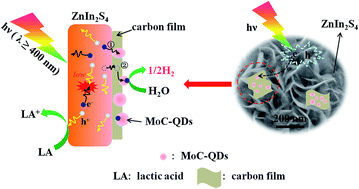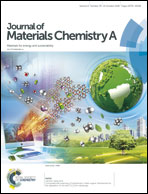Well dispersed MoC quantum dots in ultrathin carbon films as efficient co-catalysts for photocatalytic H2 evolution†
Abstract
As a promising alternative to Pt, molybdenum carbides have been widely used in many domains. Herein, we develop a co-catalyst with a 2D lamellar structure, in which MoC quantum dots are embedded in a carbon membrane uniformly (MoC-QDs/C). With the introduction of MoC-QDs/C, the flower-like MoC-QDs/C/ZnIn2S4 composite shows an unprecedented enhancement of photocatalytic performance, compared with that of pure ZnIn2S4. The optimal hydrogen generation rate of MoC-QDs/C/ZnIn2S4 is almost 48 times as much as that of pure ZnIn2S4. Besides, the enhancement mechanism is also demonstrated that MoC-QDs/C can accelerate carriers' separation and decrease the overpotential of hydrogen evolution effectively during the photocatalytic water splitting process. Moreover, this study not only provides a high-efficiency and potential co-catalyst for photocatalytic H2 production, but also is expected to come up with a new design scheme for a transition metal carbide-containing co-catalyst.



 Please wait while we load your content...
Please wait while we load your content...